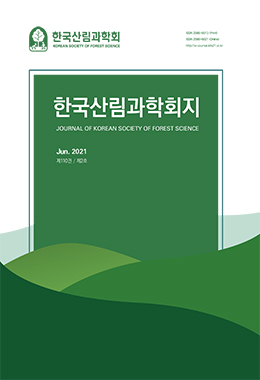본 연구는 졸참나무, 물푸레나무, 느티나무를 대상으로 용기 규격이 시설양묘 과정에 질소 양분 특성에 미치는 영향을 구명하기 위해 수행되었다. 16 종류의 용기[4 생육밀도(100, 144, 196, 256본/m2) × 4 용적(220, 300, 380, 460 cm3/구)]에서 생산된 묘목의 질소 양분 특성을 조사·분석하였다. 생육밀도와 용적에 따른 용기묘의 질소 양분 농도 및 함량 변화를 알아보기 위해 이원분산분석 및 다중회귀분석을 이용하였다. 세 수종 모두 용기 규격에 따라 묘목의 질소 양분 특성은 유의적 차이를 보였으며, 생육밀도와 용적 두 요인간의 상호작용이 질소 농도 및 함량에서 확인되었다. 세 수종 모두 질소 함량과 용적은 정의 상관관계를 보였지만, 물푸레나무의 질소 함량은 생육밀도와 부의 상관관계를 나타냈다. 추가적으로 양분벡터분석을 실시하여, 용기 규격에 따른 시비 효과 차이로 양분결핍, 과량집적 등의 양분저장능력이 다르다는 것을 확인하였다. 묘목 질소 함량을 기준으로 다중회귀분석기법을 적용한 결과, 졸참나무는 180~210본/m2과 410~460 cm3/ 구, 물푸레나무는 100~120본/m2과 350~420 cm3/구, 느티나무는 190~220본/m2과 380~430 cm3/구가 최적 용기 규격으로 최종 도출되었다. 수종별 적정 용기 적용으로 시설양묘 과정에서 양분저장능력이 높은 묘목 생산과 함께 조림 후에도 우수한 생장을 기대할 수 있을 것이다.
This study evaluated the effects of the dimensional characteristics of containers on the nitrogen status of Quercus serrata, Fraxinus rhynchophylla, and Zelkova serrata in the container nursery stage. Seedlings were grown using 16 container types [four growing densities (100, 144, 196, and 256 seedlings/m2) × four cavity volumes (220, 300, 380, and 460 cm3/cavity)]. Two-way ANOVA was performed to test the differences in nitrogen concentration and seedling content among container types. Additionally, we performed multiple regression analyses to correlate container dimensions and nitrogen content. Container types had a strong influence on nitrogen concentration and the content of the seedling species, with a significant interaction effect between growing density and cavity volume. Cavity volumes were positively correlated with the nitrogen content of the three seedling species, whereas growing density negatively affected those of F. rhynchophylla. Further, nutrient vector analysis revealed that the seedling nutrient loading capacities of the three species, such as efficiency and accumulation, were altered because of the different fertilization effects by container types. The optimal ranges of container dimension by each tree species, obtained multiple regression analysis with nitrogen content, were found to be approximately 180-210 seedlings/m2 and 410-460 cm3/cavity for Q. serrata, 100-120 seedlings/m2 and 350-420 cm3/cavity for F. rhynchophylla, and 190-220 seedlings/m2 and 380-430 cm3/cavity for Z. serrata. This study suggests that an adequate type of container will improve seedling quality with higher nutrient loading capacity production in nursery stages and increase seedling growth in plantation stages.




